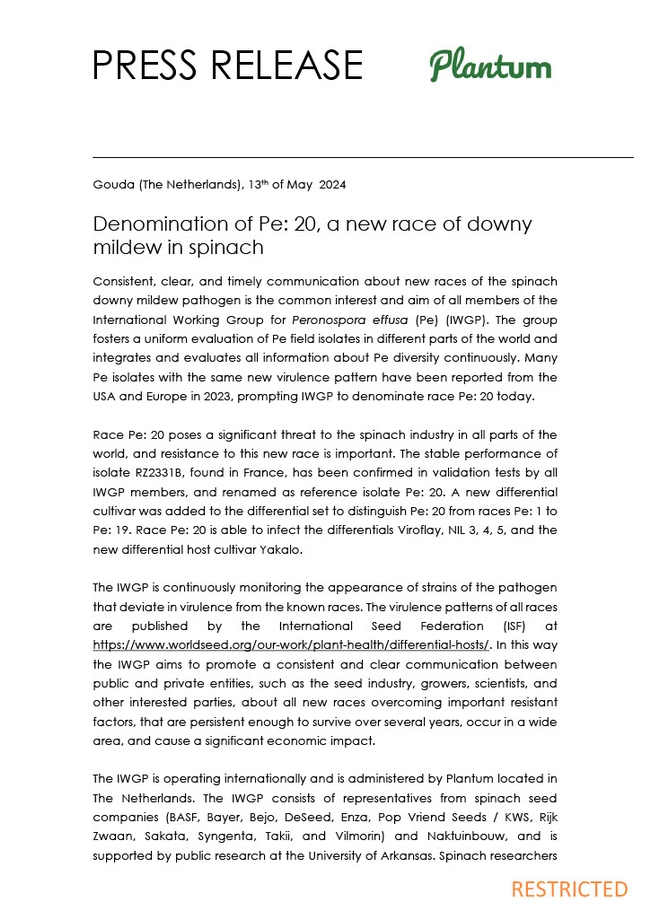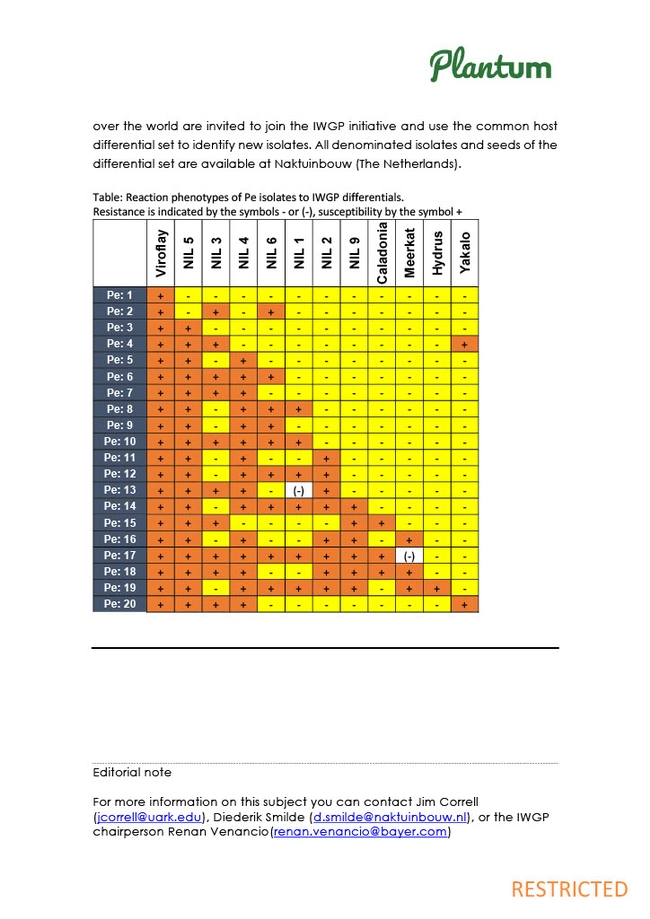- Author: Paramveer Singh
- Author: Richard Smith
University of California Cooperative Extension
2024 Automated Technology Field Day
Thursday, June 27, 2024 9:00 a.m. to 12:00 noon
Hartnell East Campus, Salinas, CA
1752 East Alisal Road, Salinas (follow signs to demonstration area)
Topics
- Growing role of automated technologies in precision weeding and other ag operations
- Automated weeders, thinners and sprayers from several companies will be demonstrated on planted crops
- Technologies appropriate for conventional and organic production will be demonstrated
- There will be ample opportunity to watch demonstrations of each machine and to discuss with company representatives.
Companies represented
- Boden Bolt
- Carbon Robotics
- Ecorobotix (Keithly Williams)
- L&Aser
- Mantis Ag Technology
- Smart Steam Applicator Organizers
- Sutton Ag
- Stout Industrial Technology
- Tensorfield
- Verdant Robotics
- Veda Farming
- Weed Spider
Organizers
- Steve Fennimore, Extension Vegetable Weed Control Specialist, UC Davis.
- Paramveer Singh, Agricultural Technology Area Advisor, Salinas.
- In cooperation with the USDA ARS, Salinas.
CA 3.0 Continuing Education Credits have been requested.
No registration fee and refreshments will be served.
For more information, call Steve Fennimore at (831) 594-1333.
2024 Automated Tech Field Day
The Michelmore lab at the University of California, Davis routinely monitors isolates of Bremia lactucae, the pathogen that causes lettuce downy mildew for their ability to overcome disease resistance genes and for insensitivity to fungicides. In 2023 they characterized 96 samples from California lettuce growers and breeders. They welcome submission of additional samples and now samples can be dropped off at UCCE Monterey County in Salinas where they will be collected and shipped directly to the lab. Please see below for instructions on sending samples.
Please fill in as completely as possible. This will help entry into the database but do not worry if some of this information is not available.
Please include this datasheet when sending isolates.
Date Collected: ____/____/_____ (UC Lab ID: _________________)
Collector: __________________________________________________
Collector email or other contract info: ___________________________________________________________
Location: _____________________________________________________________________________________________
GPS coordinates if known: ____________________________
Disease Intensity / Level of infection (circle one):
Low (Few infected plants),
Intermediate (Infected plants scattered throughout field).
Severe (Many infected plants)
Please comment whether collected from a single plant or from several plants and whether from multiple locations in the field.
Comments: __________________________________________________________________________________________________________________________________________________________________________________________________________________
Fungicide treatment: Yes No Not known
If yes: Alliete Ridomil Orondis Other:__________________
Type: Crisphead Romaine Looseleaf Butterhead Babyleaf Other:______________
Cultivar/Variety: ____________________________________________________________________________
Approximate planting/water date ________________________________________________________
Other Comments: _________________________________________________________________________________________________________
Thank you for your help. Please address questions to Charlotte Acharya (cacharya@ucdavis.edu), and/or Richard Michelmore, rwmichelmore@ucdavis.edu.
Results will be available from https://bremia.ucdavis.edu/bremia_database_main.php.
Collection and Shipping Instructions:
|
Please send leaves with fresh sporulating lesions. These should be green or only slightly chlorotic: |
Please not send leaves with dark necrotic lesions; it is difficult to rescue isolates from such samples because of bacterial contamination: |
Drop-off in Salinas:
- University of California Cooperative Extension (1432 Abbott Street, Salinas CA 93901)
- For sample drop-off, open Monday through Thursday, 8:00 a.m. through 4:00 p.m. Closed daily 12:00 to 1:00 p.m. Closed weekends and holidays.
- Contact Yu-Chen Wang with Salinas drop-off questions, yckwang@ucanr.edu or 831-201-9689
Or ship directly to lab:
Please send overnight by Fed Ex (Account # 2630-4693-5) in a box rather than an envelope (to prevent samples being crushed) along with the datasheet and the words “Refrigerate upon arrival” on the outermost packaging to:
Attn: Charlotte Acharya
The Genome Center
Genome and Biomedical Sciences Facility
451 East Health Sciences Drive
University of California
Davis, CA 95616
Tel. 607-227-3471
Please notify Charlotte Acharya (cacharya@ucdavis.edu) with the tracking number when sent.
Please time the sending so that the isolate is not in the Fed Ex system over a weekend (i.e. do not send on a Friday). Isolates can be kept in a fridge at 5oC for a few days before sending if necessary, although sending samples immediately after collection is best.
Info sheet for field collection2024 - Salinas drop-offCBA
- Author: Ian Grettenberger
- Author: Addie Abrams
Two of the worst pests plaguing lettuce growers in the Salinas Valley area are aphids, specifically lettuce-currant aphids (Nasovonia ribisnigri), and western flower thrips (Frankliniella occidentalis). Lettuce-currant aphid is an invasive pest that sets up shop in the heart of the lettuce plant and will render the crop unsellable when it reaches high enough numbers. Thrips can both cause cosmetic damage to lettuce crops and are also responsible for the spread of Salinas impatiens necrotic spot virus (INSV), the fatal lettuce disease that has driven large losses since the 2020 growing season.
While effective tools exist to control both aphids and thrips, they are almost exclusively chemical. Chemical sprays are increasingly under pressure due to changes in the regulatory framework in California as well as the development of pest resistance and discoveries of key chemistries in area watersheds1,2. The UC Davis FiVE lab biological control research program addresses a growing interest in developing alternative tools for managing both pests that do not rely on chemical applications. Biological control provides an opportunity for the management of thrips and aphids that do not rely on chemical tools.
Biological control is defined as the use of natural enemies to control a target pest. Three general categories of biological control could possibly be used as management practices for lettuce pests in the Salinas Valley area:
• Conservation biological control refers to the establishment and maintenance of resources and conditions favorable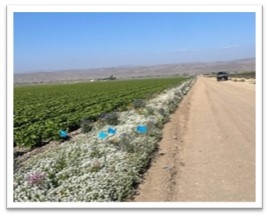
• Inundative biological control involves the release of a beneficial insect species in large numbers with the expectation that the beneficials that are released will only provide control for a short amount of time before eventually dying out. Such releases would need to be repeated at regular intervals for the duration of the growing cycle for a crop.
• Augmentative biological control refers to the use of releases of smaller numbers of beneficials to areas where a smaller population of the species already exists, but not in numbers great enough to provide adequate control of the targeted pest species. The goal of augmentative releases is to bolster already-existent populations of beneficial species so they achieve great enough numbers to provide control of the pest or pests of interest.
Conservation biological control in the Salinas Valley
Syrphid flies
Aphid pests of lettuce have been effectively managed in some lettuce production systems through the planting of sweet alyssum adjacent to and interspersed within crop fields3. Sweet alyssum is a favorite of the Syrphid fly (Diptera: Syrphidae), the primary biological control agent used to control aphid pests in lettuce. Syrphids, also called hoverflies or flower flies, are a family of black and yellow pigmented flies which resemble bees and stinging wasps. The coloration is a protective camouflage; Syrphid flies are harmless to humans. Syrphid adults are frequently seen visiting flowers for their nectar and pollen, which the insect consumes both as an energy source and to support their reproduction.
In exchange the female Syrphid flies will lay eggs in lettuce plants with lettuce aphid infestations, the primary food source for their young. Once the eggs hatch, the syrphid maggots, which are predatory on slow, soft-bodied insects, will feed on the aphids and suppress their population. Syrphid larvae are known to be voracious; some California species have been shown to consume upwards of 100 aphids per day4!
Syrphids are the intended beneficiaries of most conservation biological control in central coast lettuce fields, but other beneficial species take advantage of these resources as well.
Other predatory species love sweet alyssum
Many other biological control agents are supported by insectary plantings5. Ladybird beetles often inhabit lettuce fields and may provide some control of lettuce aphid infestations. Common lacewings (family Chrysopidae) are also found in lettuce fields and insectary plantings. Lacewings, which are only predatory in their immature or larval life stage, can provide biological control services against lettuce aphids and western flower thrips. Minute pirate bug (Orius sp.) and aphid midges (Aphidoletes aphidimyza) have also been observed in and collected from insectary plantings in lettuce fields, but it is not known the extent to which they can suppress populations of lettuce aphid or Western flower thrips.
UC Davis Fi-VE Bug IPM Lab biological control research programs
Including insectary plantings to attract naturally occurring predators has historically been the only efficient way to get beneficial species into crop fields. Newly developed technology using drones as a dispersal tool may provide another option for growers interested in using biological control as part of their pest management programs for aphids and thrips. This technology drastically reduces the time and labor required to conduct large releases of laboratory-reared beneficial insects, making the approach more feasible for growers.
As part of a research program funded by the California Department of Pesticide Regulation (CA DPR) and in collaboration with Daniel Hasegawa at USDA-ARS and with Parabug, we are studying the release of biological control agents using drones for the management of aphid and thrips pests of lettuce crops. Our three experimental programs are as follows:
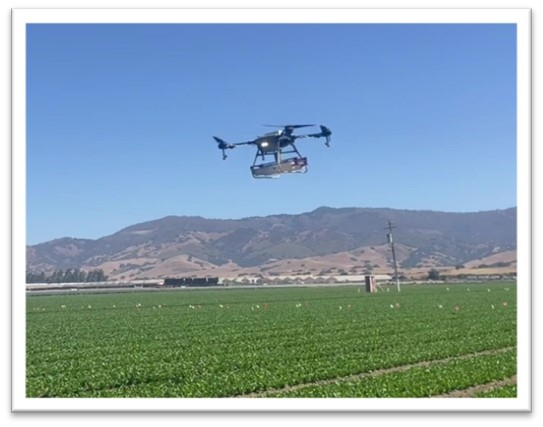
Experiments run by former Monterey County IPM Advisor Alejandro Del Pozo-Valdivia found that a single inundative release of green lacewing eggs (Chrysoperla rufilabris) in lettuce fields reduced aphid pressure six weeks after release6. Our experiment builds on Alejandro's work, examining whether repeated releases of green lacewing eggs throughout the lettuce growing cycle reduce aphid numbers. Additionally, the experiment includes two treatments aimed at suppressing western flower thrips: inundative releases of a species of predatory mite (Amblyseius cucumeris), and a combined release of both predatory mites and green lacewing eggs.
Augmentative releases to bolster non-syrphid predatory species in insectary strips and intercropped alyssum
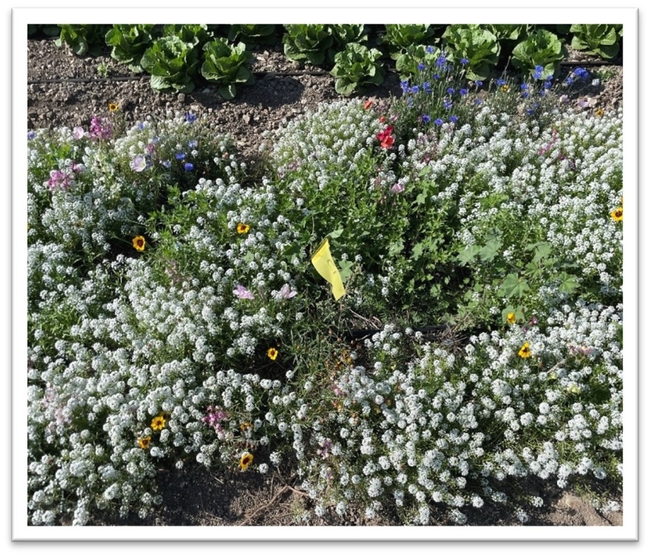
Other native predators of aphids and thrips are present in the insectary plantings growers use to attract syrphids, but their numbers are too low to provide suppression of thrips and aphids in adjacent crops. These species are reared by commercial insectaries, but using them in an inundative release could prove too costly for growers. Experiments in this program examine the use of smaller releases of these predatory species early in the growing cycle over insectary plantings. The goal is to determine whether the presence of floral resources allows the predators to stick around and build up enough in population to control aphids and thrips in the crop field. Experiments will be conducted with aphid midge (Aphidoletes aphidimyza), an aphid predator, and minute pirate bug (Orius insidiosus), a predator of western flower thrips.
Augmentative releases to manage thrips in non-crop areas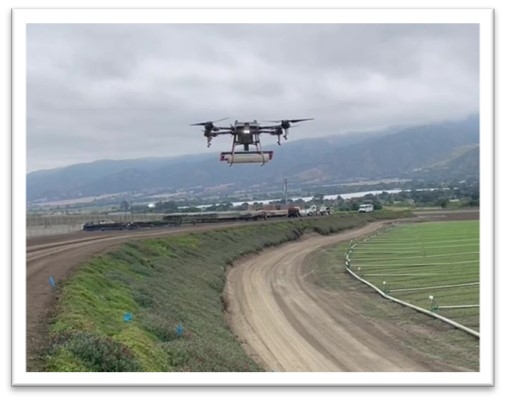
Western flower thrips plague not just vegetable crop fields but also the vegetation surrounding crop areas. In this experiment, we will examine whether releases of cucumeris mites and minute pirate bugs over field edges planted with ice plant will establish these predators in the vegetation and provide long-term suppression of western flower thrips.
Citations
- Deng, X. Study 321: Surface water monitoring for pesticides in agricultural areas in the Central Coast and southern California (2022)
- Gao, Y., Lei, Z. & Reitz, S. R. Western flower thrips resistance to insecticides: detection, mechanisms and management strategies. Pest Manag. Sci. 68, 1111–1121 (2012).
- Brennan, E. B. Agronomic aspects of strip intercropping lettuce with alyssum for biological control of aphids. Biol. Control 65, 302–311 (2013).
- Hopper, J. V., Nelson, E. H., Daane, K. M. & Mills, N. J. Growth, development and consumption by four syrphid species associated with the lettuce aphid, Nasonovia ribisnigri, in California. Biol. Control 58, 271–276 (2011).
- Bugg, R. L., Colfer, R. G., Chaney, W. E., Smith, H. A. & Cannon, J. Flower Flies (Syrphidae) and Other Biological Control Agents for Aphids in Vegetable Crops. (University of California, Agriculture and Natural Resources, 2008). doi:10.3733/ucanr.8285.
- Del Pozo-Valdivia, A. I., Morgan, E. & Bennett, C. In-Field Evaluation of Drone-Released Lacewings for Aphid Control in California Organic Lettuce. J. Econ. Entomol. 114, 1882–1888 (2021).
- Author: Michael D Cahn
Date: Wed. April 3rd, 2024
Course 8:30 am – 12 pm
Location: Monterey County Agriculture Conference Room
1432 Abbott St, Salinas CA 93901
- Learn how to use CropManage to support irrigation and nutrient management decisions and record-keeping for your crops.
- Learn how to set up your ranch and crops in CropManage.
- Learn about the latest updates and how CropManage can assist with Ag Order 4.0
CropManage is a free online decision-support tool for water and nutrient management of vegetables, berry, agronomic, vineyard and tree crops. Based on research and field studies conducted by the University of California Cooperative Extension, CropManage provides real-time recommendations for efficient and timely irrigation and fertilization applications while maintaining or improving overall yield.
At this free workshop, we will provide hands-on training so that you can learn to use the newest version of CropManage. Crops currently supported include many vegetables (carrots, cabbage, celery, broccoli, lettuce, tomato, spinach, etc.), berry crops (raspberry and strawberry), vineyards, tree crops (almond, walnut, pistachio, prunes, and pear), and agronomic crops (alfalfa and corn). CropManage is also available in Spanish.
Who should participate? Growers, farm managers, other farm staff, crop advisors, consultants, and technical service providers are welcome. The workshop is for both new and current CropManage users. Spanish translation will be available.
What to bring? This is a participatory workshop. Please bring a tablet or laptop computer so that you can follow along and participate in the exercises. Each participant will need a user account for CropManage. Please set up a free user account at https://cropmanage.ucanr.edu/ before the workshop. Please arrive early to set up your laptop or tablet computer on the wifi and get logged on to CropManage.
Registration is free: Please register here
by April 1, 2024. Seats are limited to the first 30 registrants.
Questions: Contact Michael Cahn at mdcahn@ucanr.edu / 831-214-3690
Agenda
8:30 – 8:50 am Registration and computer set-up
8:50 – 9:20 am Introduction
9:20 – 10:00 am Getting started with CropManage
10:00 to 10:15 am break
10:10 – 11:00 am Using CropManage for decision support and record-keeping
11:00 – 11:45 am Group exercise
11:45- 12 pm Discussion /Q&A/ wrap up
Continuing Education Units (CEU) for Certified Crop Advisors (CCA) have been applied.

